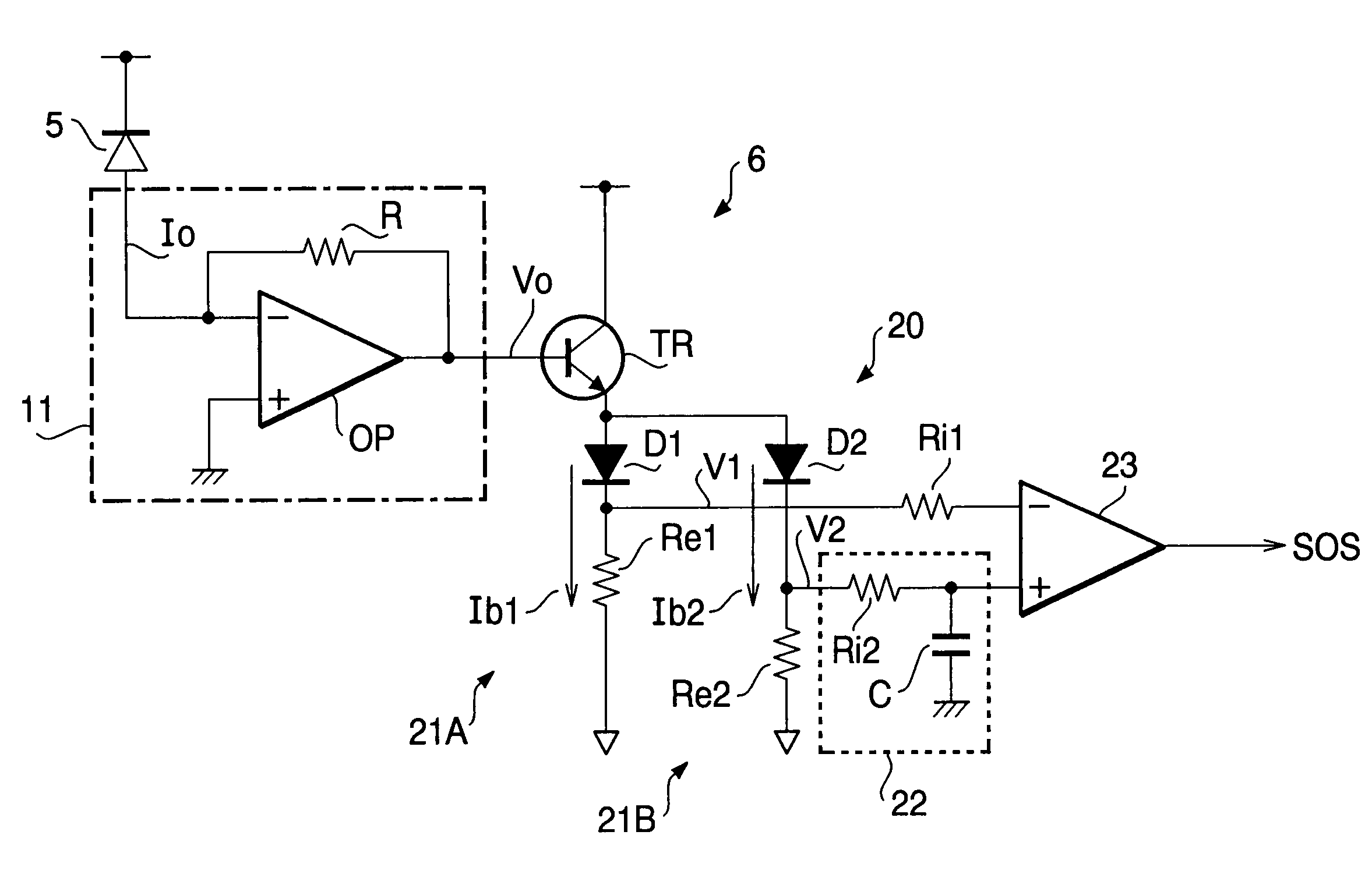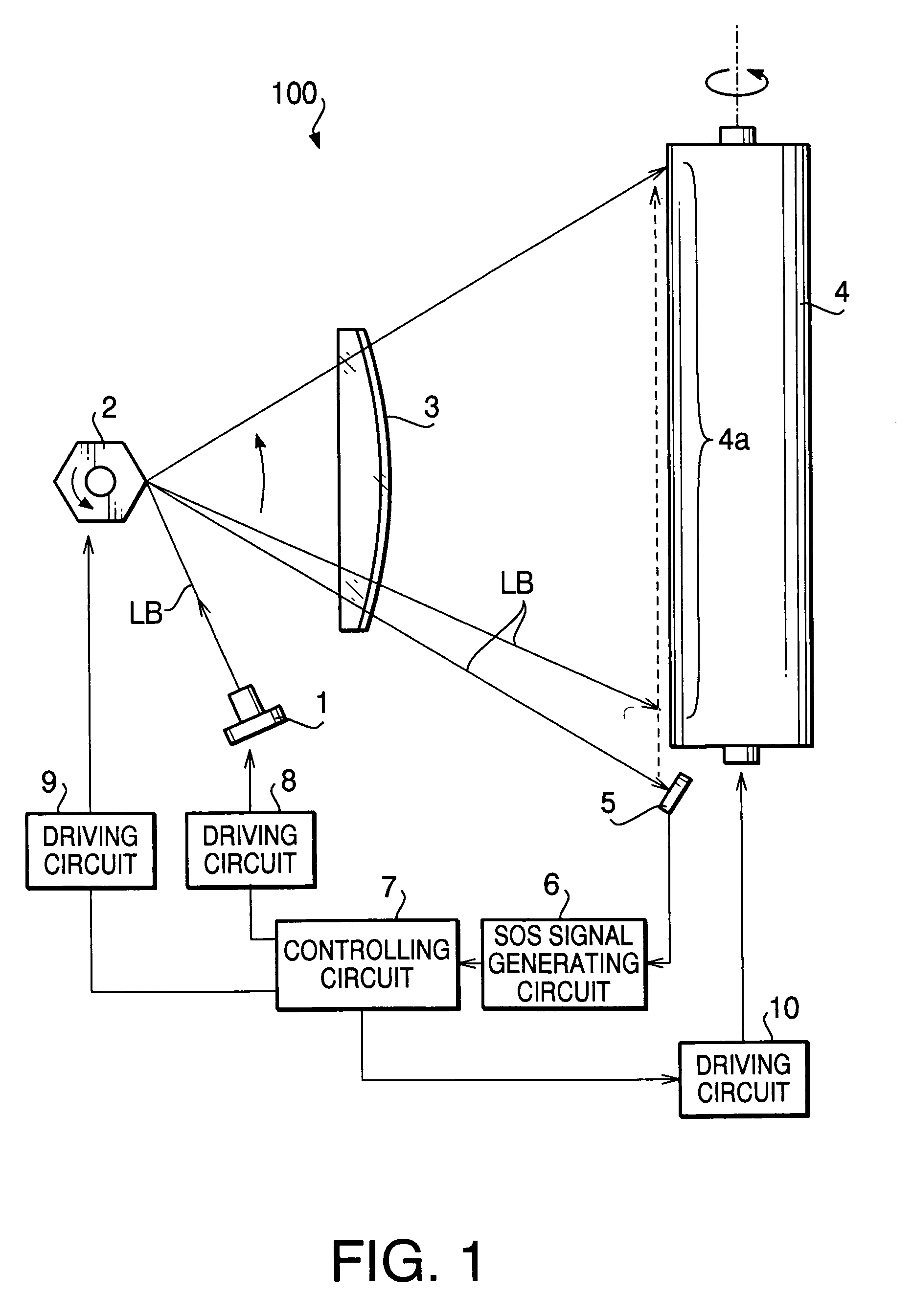Light scanning device
a scanning device and light technology, applied in the field of light scanning devices, can solve the problems synchronous timing deviation, and inability to support synchronous timing deviation, so as to reduce or eliminate the deviation of synchronous timing, reduce or eliminate the effect of synchronous timing deviation
- Summary
- Abstract
- Description
- Claims
- Application Information
AI Technical Summary
Benefits of technology
Problems solved by technology
Method used
Image
Examples
first embodiment
[0031]Next, a first embodiment of the present invention will be described with reference to the accompanying drawings. In a laser scanning device 100 shown in FIG. 1, to which the first embodiment is applied, an SOS signal is generated by an SOS signal generating circuit 6 on the basis of a light receiving signal outputted from a PD 5 while receiving a laser beam, and is inputted to a controlling circuit 7. The controlling circuit 7, based on the inputted SOS signal, controls an LD driving circuit 8 to control emission from an LD 1, and controls a polygon mirror driving circuit 9 and a photoconductive drum driving circuit 10. Thereby, the laser beam is scanned on a predetermined area 4a of the photoconductive drum 4 in synchronization with the SOS signal to draw a required pattern.
[0032]FIG. 2 is a circuit diagram of the SOS signal generating circuit 6. The SOS signal generating circuit 6 is configured with an SOS signal detecting circuit 20 and with an I-V converting circuit 11 tha...
second embodiment
[0042]FIG. 6 is a circuit diagram of an SOS signal generating circuit of a second embodiment according to the present invention, in which the same reference numbers are assigned to parts equivalent to the first embodiment. The second embodiment is different from the first embodiment in configurations of first and second bias superimposing circuits 21A and 21B of an SOS signal detecting circuit 20. The first and second bias superimposing circuits 21A and 21B are configured with first and second NPN transistors TR1 and TR2 with the same specifications, respectively. In the first bias superimposing circuit 21A, a light receiving voltage outputted from an I-V converting circuit 11 is applied to the base of the first NPN transistor TR1 via a first base resistor Rb1, while the light receiving voltage, in the second bias superimposing circuit 21B, is applied to the base of the second NPN transistor TR2 via a second base resistor Rb2 with the same resistance as the first base resistor Rb1. ...
third embodiment
[0044]FIG. 7 is a circuit diagram of an SOS signal generating circuit of a third embodiment. The configurations of first and second bias superimposing circuits 21A and 21B in the third embodiment are the same as that of the second embodiment. That is to say, the first and second bias superimposing circuits 21A and 21B are configured with NPN transistors TR1 and TR2 with the same specification, respectively, and in the first bias superimposing circuit 21A, a light receiving voltage Vo outputted from an I-V converting circuit 11 is applied to the base of the first NPN transistor TR1 via a first base resistor Rb1, while the light receiving voltage Vo, in the second bias superimposing circuit 21B, is applied to the base of the second NPN transistor TR2 via a second base resistor Rb2 with the same resistance as the first base resistor Rb1. The emitters of the first and second NPN transistors TR1 and TR2 are connected with the first and second emitter resistors Re1 and Re2, respectively, ...
PUM
 Login to View More
Login to View More Abstract
Description
Claims
Application Information
 Login to View More
Login to View More - R&D
- Intellectual Property
- Life Sciences
- Materials
- Tech Scout
- Unparalleled Data Quality
- Higher Quality Content
- 60% Fewer Hallucinations
Browse by: Latest US Patents, China's latest patents, Technical Efficacy Thesaurus, Application Domain, Technology Topic, Popular Technical Reports.
© 2025 PatSnap. All rights reserved.Legal|Privacy policy|Modern Slavery Act Transparency Statement|Sitemap|About US| Contact US: help@patsnap.com



